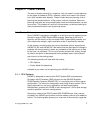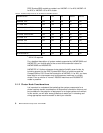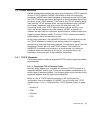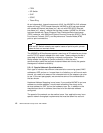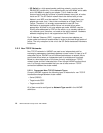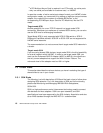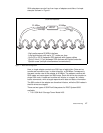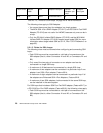Cluster Planning 13
Network types also differentiate themselves in the maximum distance they
allow between adapters, and in the maximum number of adapters allowed on
a physical network.
• Ethernet supports 10 and 100 Mbps currently, and supports hardware
address swapping. Alternate hardware addresses should be in the form
xxxxxxxxxxyy, where xxxxxxxxxx is replaced with the first five pairs of digits
of the original burned-in MAC address and
yy can be chosen freely. There
is a limit of 29 adapters on one physical network, unless a network
repeater is used.
• Token-Ring supports 4 or 16 Mbps, but 4 Mbps is very rarely used now. It
also supports hardware address swapping, but here the convention is to
use 42 as the first two characters of the alternate address, since this
indicates that it is a locally set address.
• FDDI is a 100 Mbps optical LAN interface, that supports hardware address
takeover as well. For FDDI adapters you should leave the last six digits of
the burned-in address as they are, and use a 4, 5, 6, or 7 as the first digit
of the rest. FDDI can connect as many as 500 stations with a maximum
link-to-link distance of two kilometers and a total LAN circumference of
100 kilometers.
•ATM is a point-to-point connection network. It currently supports the OC3
and the OC12 standard, which is 155 Mbps or 625 Mbps. You cannot use
hardware address swapping with ATM. ATM doesn’t support broadcasts,
so it must be configured as a private network to HACMP. However, if you
are using LAN Emulation on an existing ATM network, you can use the
emulated ethernet or Token-Ring interfaces just as if they were real ones,
except that you cannot use hardware address swapping.
• FCS is a fiber channel network, currently available as two adapters for
either MCA or PCI technology. The Fibre Channel Adapter /1063-MCA,
runs up to 1063 Mb/second, and the Gigabit Fibre Channel Adapter for
PCI Bus (#6227), announced on October 5th 1998, will run with 100 MBps.
Both of them support TCP/IP, but not hardware address swapping.
•SLIP runs at up to 38400 bps. Since it is a point-to-point connection and
very slow, it is rarely used as an HACMP network. An HACMP cluster is
much more likely to use the serial port as a non-TCP/IP connection. See
below for details.
• SOCC is a fast optical connection, again point-to-point. This is an optical
line with a serial protocol running on it. However, the SOCC Adapter
(Feature 2860) has been withdrawn from marketing for some years now.
Some models, like 7013 5xx, offer SOCC as an option onboard, but these
are rarely used today.





